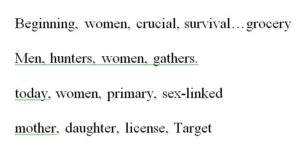Which category do you fall under, when it comes to using notes for a speech:
1. The Forgetter. You are afraid you are going to forget what you want to say, so you use notes.
2. The Writer. You worked hard to get your wording just so and want to say it just like you wrote it.
3. The “Wing-it” Speaker. Plan out what I’m going to say? You’re kidding, right?
4. The Memorizer. You memorize your speech, almost word-for-word.
5. The “Talking Points” Speaker. You jot down a few key words to jog your memory.
6. The PowerPoint Slide Reader. Please—don’t be THAT speaker.
I admit it; I have been in each of those categories. What I have learned, is that each of the categories has some benefits and in my best presentations, I combine many of them, at least in preparation for a talk. However, the approach that I have found to be most successful for me and many others is to use a “Talking Points” approach.
Preparation
Step 1: Write out your speech. Pay careful attention to the introduction, the conclusion and the transitions. Here’s a nifty trick to help you trigger your memory as you transition to different parts of your speech: use the same word or phrase from the end of one sentence to the beginning of another as you transition. For example: “There are only 3 things we have to fear: 1. Bad men , 2. Bad decisions and 3. Bad breath. Bad breath is a bigger problem than you might think . . .” The phrase “bad breath” triggers my memory for the next sentence.
Step 2: Practice it a few times, revising it as necessary.
Step 3: Write out key words and phrases. You can also draw pictures/symbols. Try not to have more than 4-5 words per sentence or per line. Use a big font if typing. Double space.
It might look something like this:
 Step 4: Set your written speech aside and practice from the keywords (OK to look back at first, but then resist the urge). Practice your introduction and conclusion so that you can at least do those from memory—those are the parts people will remember the most.
Step 4: Set your written speech aside and practice from the keywords (OK to look back at first, but then resist the urge). Practice your introduction and conclusion so that you can at least do those from memory—those are the parts people will remember the most.
You don’t have to say your speech the same way twice—No one will know if you use different words!
In fact, by allowing yourself the freedom to deviate from what you’ve written, you are less likely to “blank out” if your mind can’t think of the one exact phrase you had written.
Giving the speech
The MAIN THING to remember is: Speak to People, Not Paper! Don’t look at your notes and have your mouth moving at the same time. Eye contact while speaking is important for audience engagement. Look down. Grab a few key words on a line. Look up. Speak. Repeat.


I am always the Forgetter, I am just getting to learn the soft skills for giving out a killer presentation. I am still a long way to go.
What’s up, just wanted to say, I loved this article.
It was funny. Keep on posting!